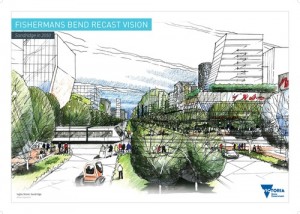
ENVIRONMENTALLY FRIENDLY: An artist’s impression of Sandridge in 2050.
This is an opportunity to focus on the future. This is all about the future, given they’re taking their time to plan correctly, to think about how things are going to be done and to think about alternative means of transport. It’s the most wonderful opportunity to show what can and will happen.Terry Taylor, Fishermans Bend Realty
Fishermans Bend is on track to becoming a world leader in sustainability.
The Urban Renewal Area will be planned with an environmentally friendly focus to become Australia’s largest Green Star community.
The Green Star rating was developed by the Green Building Council of Australia.
The national, not-for-profit organisation aims to develop a sustainable property industry in Australia by encouraging green building practices.
The GBCA applauded the Victoria Government for pursuing the rating.
“The significance of the site, the scale of the project and the far-reaching implications of ‘getting it right’ make achieving a Green Star – Communities rating an essential component of smart, sustainable planning,” the council says.
The rating will boost Fishermans Bend’s appeal even further.
Already attractive owing to its impressive location just 1km southwest of Melbourne’s CBD, the 465-ha site will now also be a beacon of cleaner, greener living.
It is expected other developers will take note and the vision will flow to the outskirts of the city.
The Green Star commitment was revealed in the Government’s recast vision for Fishermans Bend. The document ties in with an update of Plan Melbourne, a city plan to 2051.
To create a sense of what Fishermans Bend can become, the draft vision document talks about the development in the present tense as if it’s now 2050.
“Melbourne is now a city approaching 8 million people and experiences more hot days and extreme weather events,” says one futuristic passage.
“The city also operates in an increasingly connected and competitive global environment. Fishermans Bend plays a vital role in ensuring that Melbourne meets the challenges and seizes the opportunities of this changing world.”
Another passage says: “A generous tree canopy keeps Fishermans Bend cool in summer. Not only are the public spaces green – so, too, are the buildings. The buildings incorporate vertical and rooftop greening — saving water while supporting a rich biodiversity throughout the area. A network of leafy boulevards and green links connect neighbourhoods and public spaces, providing a focus for city life as well as high quality public transport, walking and cycling infrastructure.”
One of the more ambitious visions for Fishermans Bend is the removal of cars from the transport mix.
“Car parking has been reduced. In fact, less than one in five trips are now made by private car. Instead, the efficient and direct public transport network reduces traffic congestion and carbon emissions,” the draft vision says.
Also in the mix are “strong links” of dedicated cycling and walking links across Fishermans Bend’s five precincts – Montague, Wirraway, Sandridge, Lorimer and Fishermans Bend Employment Precinct.
Purpose-built water recycling is also planned.
Plan Melbourne 2016 anticipates that Melbourne’s population will increase from 4.4 million to 7.7 million by 2051
